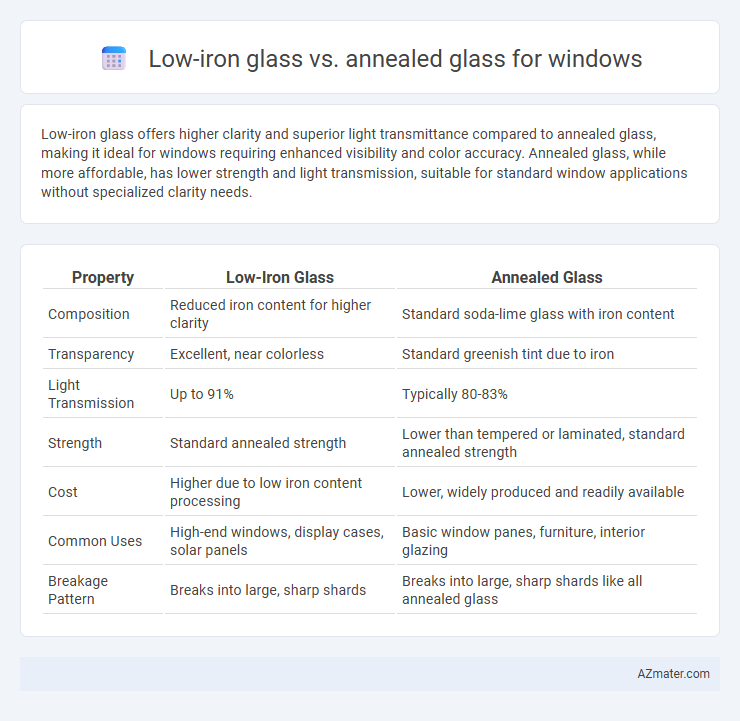Low-iron glass offers higher clarity and superior light transmittance compared to annealed glass, making it ideal for windows requiring enhanced visibility and color accuracy. Annealed glass, while more affordable, has lower strength and light transmission, suitable for standard window applications without specialized clarity needs.
Table of Comparison
| Property | Low-Iron Glass | Annealed Glass |
|---|---|---|
| Composition | Reduced iron content for higher clarity | Standard soda-lime glass with iron content |
| Transparency | Excellent, near colorless | Standard greenish tint due to iron |
| Light Transmission | Up to 91% | Typically 80-83% |
| Strength | Standard annealed strength | Lower than tempered or laminated, standard annealed strength |
| Cost | Higher due to low iron content processing | Lower, widely produced and readily available |
| Common Uses | High-end windows, display cases, solar panels | Basic window panes, furniture, interior glazing |
| Breakage Pattern | Breaks into large, sharp shards | Breaks into large, sharp shards like all annealed glass |
Introduction to Low-Iron Glass and Annealed Glass
Low-iron glass contains significantly reduced iron oxide compared to standard annealed glass, resulting in higher light transmittance and enhanced clarity, ideal for architectural windows that demand superior aesthetics and natural lighting. Annealed glass undergoes a controlled cooling process that relieves internal stresses, providing basic strength but lacking the enhanced optical qualities of low-iron glass. Choosing between low-iron and annealed glass depends on the specific requirements for transparency, color neutrality, and safety in window applications.
Composition and Manufacturing Differences
Low-iron glass contains a significantly reduced amount of iron oxide compared to standard annealed glass, resulting in higher clarity and less greenish tint. Annealed glass is produced through a slow cooling process after forming, which relieves internal stresses, whereas low-iron glass manufacturing involves raw materials with minimal iron content combined with similar annealing techniques. The low-iron composition enhances optical performance, making it ideal for applications requiring maximum transparency, while annealed glass provides basic structural integrity and cost-effectiveness.
Optical Clarity: Low-Iron vs Annealed Glass
Low-iron glass offers superior optical clarity compared to annealed glass due to its reduced iron content, which minimizes the greenish tint typically seen in standard glass. This enhanced transparency allows more natural light to pass through, making low-iron glass ideal for windows requiring maximum visibility and true color rendering. In contrast, annealed glass contains higher iron levels, resulting in lower optical clarity and a slight color distortion, which may affect the appearance of external views.
Light Transmission and Color Accuracy
Low-iron glass offers superior light transmission, typically allowing up to 91-92% of visible light to pass through, compared to annealed glass which generally transmits around 80-85%. This higher transparency of low-iron glass results in more accurate color representation and reduces the greenish tint commonly seen in standard annealed glass. For windows, choosing low-iron glass enhances natural daylight quality and ensures true-to-life colors, especially beneficial in architectural and display applications.
Strength and Durability Comparison
Low-iron glass typically offers enhanced clarity and aesthetic appeal but matches annealed glass in terms of strength and durability, both being standard float glass products without additional tempering. Annealed glass is more prone to breakage under impact as it lacks the heat treatment found in tempered or laminated variants, whereas low-iron glass maintains similar structural integrity. For applications demanding high strength and durability, tempered or laminated low-iron glass provides superior performance compared to annealed glass in window installations.
Energy Efficiency and UV Protection
Low-iron glass offers superior clarity and increased solar heat gain, making it ideal for maximizing natural light while maintaining energy efficiency in windows. Annealed glass, while more affordable, has standard iron content that can reduce visible light transmission and slightly lower thermal performance compared to low-iron variants. Both glass types provide UV protection, but low-iron glass enhances energy savings by optimizing solar heat control and reducing the need for artificial lighting.
Cost Analysis: Which is More Economical?
Low-iron glass typically costs 20-30% more than annealed glass due to its enhanced clarity and minimal green tint, which is ideal for premium window applications. Annealed glass is more economical upfront, making it a popular choice for standard residential and commercial windows where budget constraints are key. When considering long-term investment, low-iron glass can reduce the need for replacement and increase property value, potentially offsetting its higher initial cost through improved aesthetics and energy efficiency.
Applications in Residential and Commercial Windows
Low-iron glass offers superior clarity and light transmission, making it ideal for upscale residential windows where aesthetics and natural daylight are priorities. Annealed glass, with its standard composition and cost-efficiency, suits commercial windows requiring basic functionality without the premium clarity. Both types are commonly used in window installations, but low-iron glass is preferred for high-end architectural designs, while annealed glass remains a practical choice for most everyday residential and commercial applications.
Aesthetic Benefits and Design Flexibility
Low-iron glass offers superior clarity and a true color representation, enhancing natural light transmission and making window views more vibrant compared to the slightly green-tinted annealed glass. Its high transparency allows architects and designers greater flexibility in creating sleek, modern aesthetics with minimal color distortion, ideal for premium residential and commercial projects. Annealed glass, while more cost-effective, has limited design appeal due to its lower clarity and less refined finish, impacting the overall sophistication of window applications.
Choosing the Right Glass: Factors to Consider
Low-iron glass offers superior clarity and enhanced light transmission, making it ideal for windows where color fidelity and maximum natural light are priorities, while annealed glass provides basic durability and is more cost-effective for less critical applications. Consider factors such as desired aesthetic quality, energy efficiency requirements, and the level of safety needed, as annealed glass is more prone to breakage and lacks the strength provided by tempered or laminated alternatives. Climate conditions, budget constraints, and architectural design also influence the optimal choice between low-iron and annealed glass for window installations.

Infographic: Low-iron glass vs Annealed glass for Window
 azmater.com
azmater.com